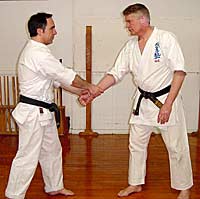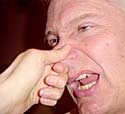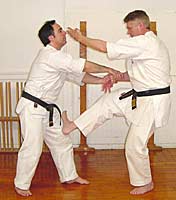Escaping The Wrist Grab
Part 3 - The Two Arm Wrist Grab
by Christopher Caile

Editor's Note:
This is the third in a series of articles on escaping from wrist grabs.
Part
1- From The Same Side discussed several self-defense options
against a same side grab. Part
2 - From The Opposite Side discussed a wrist grabbed by
the opponent's opposite arm. Part 4 will discuss escaping from a reverse
wrist grab.
Historically wrist grabs were often used to stopping an opponent from
using of a weapon. For this reason older style Japanese jujutsu system
were replete with various types of wrist pins, grabs and other manipulations.
Today, however, wrist grabs are most often used by one person to control
or pull another person.
This article will illustrate several self-defense techniques useful in
escaping the two arm wrist grab, as seen above. The advantages and disadvantages
of each are also discussed.
Throughout this series we have stressed the need for any self-defense
technique to be effective, easily applied and useful for a weaker person
against a stronger one. (1)
There should be a "continuum of force" in any technique --
basic release methods should start with just a basic release and progress
through being able to render the assailant unconscious, incapacitated
or immobilized.
Here we are examining the two arm wrist grab. For the person attacked,
this attack can be scary, but it is fatally flawed -- it ties up the two
hands and arms of the attacker and focuses his attention on the grabbed
wrist. The defender, however, has a free hand, elbow, head, two knees
and feet available as weapons.
Preliminary Techniques
 If
the grab is non-threatening or some playful episode, the defender can
usually get the attacker to let go with any number of simple but painful,
or other distraction techniques. One I especially like in this situation
is a simple grab and twist of the nose (seen here), an under arm pinch
(not shown). See: Ouch!
The Mighty Little Pinch For Self-defense. Another useful
(but one step up in escalation) technique is an open hand slap across
the face. If
the grab is non-threatening or some playful episode, the defender can
usually get the attacker to let go with any number of simple but painful,
or other distraction techniques. One I especially like in this situation
is a simple grab and twist of the nose (seen here), an under arm pinch
(not shown). See: Ouch!
The Mighty Little Pinch For Self-defense. Another useful
(but one step up in escalation) technique is an open hand slap across
the face.
 A
more serious and escalated initial response is a back of the fingers slap
into the eyes (known as splashing hands in some Kung Fu styles) and/or
(here seen combined) a low kick. The kick could be to the groin (not shown),
or (shown here) a downward heel kick to the inside of the attacker's leg
that drives the knee outward and causes the leg to straighten. A
more serious and escalated initial response is a back of the fingers slap
into the eyes (known as splashing hands in some Kung Fu styles) and/or
(here seen combined) a low kick. The kick could be to the groin (not shown),
or (shown here) a downward heel kick to the inside of the attacker's leg
that drives the knee outward and causes the leg to straighten.
Be very careful with this type kick since it can easily injure or tear
the ligaments of the knee and/or the knee cap. Another simple distraction
includes a backhand slap (keeping the fingers loose) of the assailant's
testicles (if male) with the back of the free hand.
These distraction or stunning techniques alone will often end the attack.
While in Okinawa a few years ago, I was reminded by several well known
masters that these type distraction or stunning techniques could be added
to any technique. And if we think of kata and the natural position and
upright stance from which they begin, it is easy to image how these techniques
could be used as an initial response to a variety of grabbing attacks.
(2) (In the following two self-defense techniques
shown it is assumed that the defender could initially use any of the initial
techniques shown or illustrated above.)
Self-Defense Escapes
The first basic self-defense sequence illustrated here is similar to
those illustrated in the first to articles in this series -- to simply
to raise your grabbed fist to the inside of the two grabbing arms and
while grabbing your own fist with your other arm to pull back, using your
weight against the attacker's thumbs -- the weak link in most wrist grabs.
The advantages of this technique are that it is quick and simple. The
disadvantage is that if the defender is significantly weaker than the
attacker, the technique often just won't work. If the attacker holds the
grabbed arm down, not allowing it to angle upward so the fist can rise
(be pulled up) between the grabbing forearms, it is significantly more
difficult to do this technique -- it is harder to grab your own fist,
and more strength is require to pull free. Another drawback is that even
if the defender breaks the hold, he or she is still in front of the assailant,
who has not been controlled. Thus this technique while widely taught,
is problematic at best -- a short term solution, if it works at all.
A second approach, which I much prefer, closely parallels that used against
the other wrist grabs as well -- a technique drawn from the karate kata
Saiha.
The attacker grabs with both hands (not shown) as in the first sequence.
Here the initial first response is not directly resist, but to drop while
moving forward - dropping your weight along with your elbow. Your weight
and not muscle strength, turns your forearm in the attacker's grip so
you hand rises above the level of the attacker's forearm. You can then
(seen from opposite side) hook your fingers over the attacker's arm (photo
3) to create a position of leverage. (3)
As you continue to move forward (4) into
a side facing horse stance, the leverage of your arm position with the
weight behind it will break the grip on your arms -- almost without any
muscle strength. If you were just seeking to break free this would be
the end. But if you are countering a serious attack, add a nose strike
with the palm of the opposite hand, and then grab the hair to pull the
head down into a backfist and your drop backward into a wider horse stance(as
seen). (5)
This is where the fun begins. If you follow saiha kata there is a lot
more to follow. And it's devastating.
(Continued
On Next page)
Footnotes:
(1) When teaching karate
and self-defense at the State University of New York at Buffalo (SUNY),
we did considerable research on the effectiveness of various self-defense
techniques. Surprisingly, we found that many self-defense techniques widely
taught just did not work. The defenders if significantly smaller and weaker,
could not escape determined assailants who resisted, or the techniques
themselves were difficult to perform.
(2) Several of the old
Okinawan techniques of this type include the testicle slap and eye techniques
discussed above as well as a spit in the face of an opponent.
(3) The action of moving
in three directions at once is confusing to the defender. He expects a
resistant pull back, but instead you move in and drop. The move of the
forearm is secondary to his expectations, lost within the total movement
and difficult to oppose with only thumb strength.
(4) When performing saiha
kata the defender moves in further so the feet come together (in the above
example the feet are kept somewhat separated in a small horse stance)
with the initial elbow technique. This too can be effective, since the
elbow once free of the two arm grab can turn into an elbow smash against
the chest or side of the face. The technique shown here, however, is modified.
The reason are two. First, it is desirable to isolate the escape so it
can be easily practiced and secondly because with a follow-up elbow strike
to the head, the head is often propelled so far backward that a follow-up
hair grab and backhand strike cannot be executed.
(5) As you step into the opponent with your elbow,
the leverage forces his elbows outward and his body forward into the palm
strike to the face (if this elected). This drives the head backward, immediately
to be grabbed and pulled forward - creating a damaging whip-like effect
if done quickly and powerfully.
An alternative in this two arm wrist grab self-defense
sequence drawn from the kata saiha, as in others illustrated in this article
series, is to grab the opponent's left arm (after the release) while doing
a backhand strike into the face (show in previous articles. If this alternative
is used you continue your body motion forward into the attack rather than
dropping back into horse stance (as illustrated above). A follow up in
this situation could include an arm bar. Either option is viable, and
both should be practiced since you can never be totally sure how an opponent
will react to your initial technique.
|